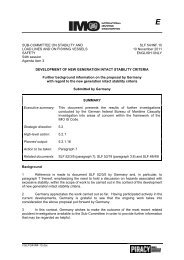Examination of the intact stability and the seakeeping behaviour
Examination of the intact stability and the seakeeping behaviour
Examination of the intact stability and the seakeeping behaviour
You also want an ePaper? Increase the reach of your titles
YUMPU automatically turns print PDFs into web optimized ePapers that Google loves.
2.1 Description <strong>of</strong> <strong>the</strong> utilised <strong>seakeeping</strong> simulation method<br />
<strong>the</strong> roll motion or <strong>the</strong> highly nonlinear restoring moments, <strong>the</strong> surge <strong>and</strong> roll motion have to<br />
be simulated nonlinearly in <strong>the</strong> time domain. The linearisation <strong>of</strong> <strong>the</strong> roll motion for example,<br />
would imply replacing <strong>the</strong> lever arm curve with a straight line having a gradient corresponding<br />
to GM. It is easy to underst<strong>and</strong>, that such a simplication is not permissible. Therefore <strong>the</strong><br />
roll <strong>and</strong> <strong>the</strong> surge motion are simulated nonlinearly in <strong>the</strong> time domain, based on <strong>the</strong> formulas<br />
described in <strong>the</strong> following.<br />
2.1.2.1 Roll motion<br />
The roll motion is calculated in <strong>the</strong> time domain according to <strong>the</strong> equation <strong>of</strong> motion 2.1 shown<br />
below:<br />
¨ϕ =<br />
[( ) ( ) ] (<br />
I xz ¨ψ + ψ ϕ˙<br />
2 cos ϕ − ¨ϑ + ϑ ϕ˙<br />
2 sin ϕ − m g − ¨ζ<br />
)<br />
h s<br />
I xx − I xz (ψ sin ϕ + ϑ cos ϕ)<br />
+ M W ind + M Sway&Y aw + M W ave + M T ank − M D<br />
I xx − I xz (ψ sin ϕ + ϑ cos ϕ)<br />
(2.1)<br />
with<br />
ˆ ϕ, ϑ <strong>and</strong> ψ, <strong>the</strong> angles to describe roll, pitch <strong>and</strong> yaw as well as ζ describing <strong>the</strong> heave<br />
direction which coincides with z <strong>of</strong> <strong>the</strong> hull-bound coordinate system.<br />
ˆ h s , <strong>the</strong> righting lever in seaway according to Grim's [10] equivalent wave method.<br />
ˆ m is <strong>the</strong> mass <strong>of</strong> <strong>the</strong> ship <strong>and</strong> g is <strong>the</strong> gravitational acceleration.<br />
ˆ M W ind , M Sway&Y aw , M W ave <strong>and</strong> M T ank , <strong>the</strong> exiting roll moments due to wind, sway <strong>and</strong><br />
yaw, waves <strong>and</strong> uid in tanks or ooded compartments.<br />
ˆ M D , <strong>the</strong> nonlinear damping moment depends on ship's speed. It is determined by using<br />
damping coecients according to Blume [9].<br />
ˆ I xx <strong>and</strong> I xz are <strong>the</strong> moment <strong>of</strong> inertia <strong>and</strong> <strong>the</strong> centrifugal moment.<br />
Before <strong>the</strong> simulation is started, <strong>the</strong> cross curves <strong>of</strong> <strong>the</strong> ship are calculated, to avoid <strong>the</strong> timeconsuming<br />
calculation <strong>of</strong> <strong>the</strong> actual righting lever in seaways for each time step <strong>of</strong> <strong>the</strong> simulation.<br />
The actual value during simulation is interpolated from <strong>the</strong> pre-calculated righting levers using<br />
Grim's [10] equivalent wave method.<br />
2.1.2.2 Surge Motion<br />
Finally, <strong>the</strong> surge motion is simulated based on <strong>the</strong> ship's resistance, speed, mass (including added<br />
hydrodynamic mass) <strong>and</strong> surge-inducing wave forces. The wave force is calculated, assuming a<br />
hydrostatic pressure distribution under <strong>the</strong> water surface at half <strong>of</strong> ship's draught. This means,<br />
that at each frame <strong>the</strong> force <strong>of</strong> buoyancy is perpendicular to this line <strong>of</strong> equivalent pressure at<br />
half draught. The surge motion is simulated based on <strong>the</strong> approach 2.2 below.<br />
[ 2R (v0 ) R (v o )<br />
¨ξ = − ˙ξ +<br />
v 0 m ∗ v0 2 ξ˙<br />
2 + △R ]<br />
m∗ m ∗ (2.2)<br />
with<br />
ˆ R, representing <strong>the</strong> resistance curve in still water conditions<br />
9

















